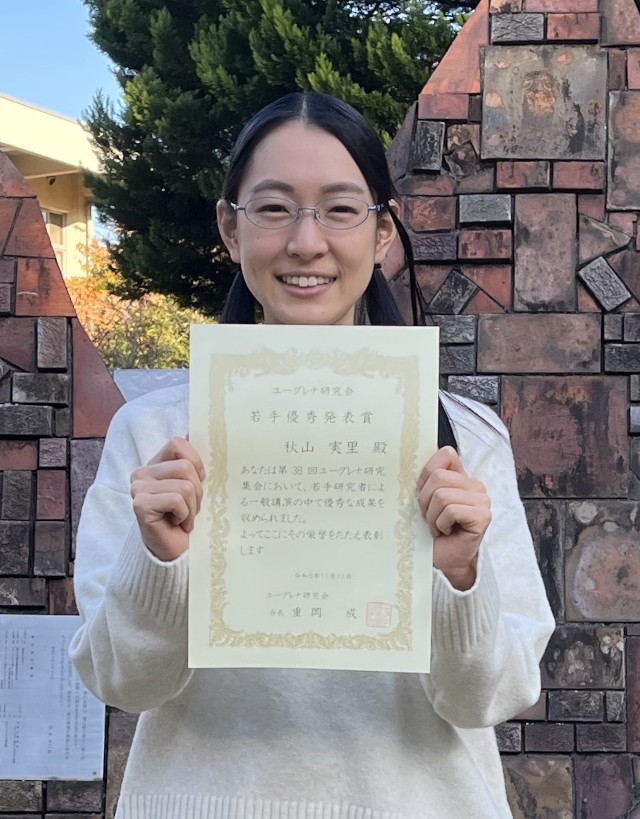[Graduate School of Agriculture] AKIYAMA Minori wins the Young Scientist Excellent Presentation Award at the Euglena Research Association’s 38th Research Conference
Dec. 23, 2023

At the 38th Research Conference of the Euglena Research Association, held at the Ikuta Campus of Meiji University on November 11, 2023, AKIYAMA Minori, a second-year master student at the Environmental Biotechnology (Associate Professor OSANAI Takashi) Lab in the Agricultural Chemistry Program, Graduate School of Agriculture, received the Young Scientist Excellent Presentation Award.
Presentation subject
Analysis of the Relationship between Hydrogen Production and NADH/NAD+ Ratio by Synechocystis sp. PCC 6803
In recent years, as fossil fuel depletion and global warming have become issues, new technologies are being sought to realize a carbon-neutral society. Cyanobacteria are oxygenic photosynthetic bacteria that produce a variety of substances, including hydrogen and organic acids, from carbon dioxide fixed by photosynthesis. Hydrogen, as a fuel, and organic acids are useful substances that are expected to be utilized as raw materials for bioplastics and in pharmaceutical and industrial applications. Therefore, cyanobacteria are considered to be promising hosts for the production of useful materials to replace fossil fuels.
A cyanobacterium known as Synechocystis sp. PCC 6803 (hereinafter, “Synechocystis”) can produce hydrogen via an enzyme called hydrogenase, using the reducing power of substances such as NADH or ferredoxin. Reducing power has two forms, oxidized and reduced, and is used repeatedly by oxidation or reduction in intracellular reactions. Therefore, it is possible to increase hydrogen production by increasing the absolute amount of reducing power and the proportion of the reduced form.
Synechocystis also produces organic acids such as succinic acid, lactic acid, and acetic acid in hydrogen-producing culture conditions. Like hydrogen, NADH is used to produce succinic acid and lactic acid. On the other hand, the process of producing acetic acid yields NADH. For this reason, genetically modified strains deficient in the enzymes involved in the production of succinic acid, lactic acid, and acetic acid may alter the balance between the oxidation and reduction of NADH. Using genetically modified strains deficient in enzymes involved in the production of succinic acid, lactic acid, and acetic acid, it was investigated that whether hydrogen production in Synechocystis is affected by the absolute amount of NADH and the proportion of the reduced form by analyzing the hydrogen production of each strain, the absolute amount of NADH, and the proportion of the reduced form.
The results showed that NADH concentration decreased when hydrogen production was changed to either increase or decrease compared with the wild strain. In addition, it was found that the NADH/NAD+ ratio, which represents the proportion of the reduced form of NADH, decreases when hydrogen production decreases. These findings indicate that hydrogen production in Synechocystis is related to the absolute amount of NADH and the proportion of the reduced form, and suggest that measurement of the NADH concentration and NADH/NAD+ ratio may be useful in the search for genetically modified strains promising for hydrogen production. The results of this research may contribute to a better understanding of hydrogen production by Synechocystis.
≪Japanese version≫
Presentation subject
Analysis of the Relationship between Hydrogen Production and NADH/NAD+ Ratio by Synechocystis sp. PCC 6803
In recent years, as fossil fuel depletion and global warming have become issues, new technologies are being sought to realize a carbon-neutral society. Cyanobacteria are oxygenic photosynthetic bacteria that produce a variety of substances, including hydrogen and organic acids, from carbon dioxide fixed by photosynthesis. Hydrogen, as a fuel, and organic acids are useful substances that are expected to be utilized as raw materials for bioplastics and in pharmaceutical and industrial applications. Therefore, cyanobacteria are considered to be promising hosts for the production of useful materials to replace fossil fuels.
A cyanobacterium known as Synechocystis sp. PCC 6803 (hereinafter, “Synechocystis”) can produce hydrogen via an enzyme called hydrogenase, using the reducing power of substances such as NADH or ferredoxin. Reducing power has two forms, oxidized and reduced, and is used repeatedly by oxidation or reduction in intracellular reactions. Therefore, it is possible to increase hydrogen production by increasing the absolute amount of reducing power and the proportion of the reduced form.
Synechocystis also produces organic acids such as succinic acid, lactic acid, and acetic acid in hydrogen-producing culture conditions. Like hydrogen, NADH is used to produce succinic acid and lactic acid. On the other hand, the process of producing acetic acid yields NADH. For this reason, genetically modified strains deficient in the enzymes involved in the production of succinic acid, lactic acid, and acetic acid may alter the balance between the oxidation and reduction of NADH. Using genetically modified strains deficient in enzymes involved in the production of succinic acid, lactic acid, and acetic acid, it was investigated that whether hydrogen production in Synechocystis is affected by the absolute amount of NADH and the proportion of the reduced form by analyzing the hydrogen production of each strain, the absolute amount of NADH, and the proportion of the reduced form.
The results showed that NADH concentration decreased when hydrogen production was changed to either increase or decrease compared with the wild strain. In addition, it was found that the NADH/NAD+ ratio, which represents the proportion of the reduced form of NADH, decreases when hydrogen production decreases. These findings indicate that hydrogen production in Synechocystis is related to the absolute amount of NADH and the proportion of the reduced form, and suggest that measurement of the NADH concentration and NADH/NAD+ ratio may be useful in the search for genetically modified strains promising for hydrogen production. The results of this research may contribute to a better understanding of hydrogen production by Synechocystis.
≪Japanese version≫


